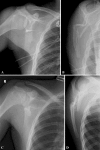Outcomes of nonoperatively treated displaced scapular body fractures
- PMID: 21161746
- PMCID: PMC3069270
- DOI: 10.1007/s11999-010-1670-4
Outcomes of nonoperatively treated displaced scapular body fractures
Abstract
Background: Displaced scapular body fractures most commonly are treated conservatively. However there is conflicting evidence in the literature regarding the outcomes owing to retrospective design of studies, different classification systems, and diverse outcome tools.
Questions/purposes: The functional outcome after nonoperative management of displaced scapular body fractures was assessed by change in the DASH (Disability of Arm, Shoulder and Hand) score; (2) the radiographic outcome was assessed by the change of the glenopolar angle (GPA); and (3) associated scapular and extrascapular injuries that may affect outcome were identified.
Patients and methods: Forty-nine consecutive patients were treated with early passive and active ROM exercises for a displaced scapular body fracture. We followed 32 of these patients (65.3%) for a minimum of 6 months (mean, 15 months; range, 6-33 months). Mean age of the patients was 46.9 years (range, 21-84 years) and the mean Injury Severity Score (ISS) was 21.5 (range, 5-50). Subjective functional results (DASH score) and radiographic assessment (fracture union, glenopolar angle) were measured.
Results: All fractures healed uneventfully. The mean change of glenopolar angle was 9° (range, 0°-20°). The mean change of the DASH score was 10.2, which is a change with minimal clinical importance. There was a correlation between the change in this score with the ISS and presence of rib fractures.
Conclusions: Satisfactory outcomes are reported with nonoperative treatment of displaced scapular body fractures. We have shown that the severity of ISS and the presence of rib fractures adversely affect the clinical outcome.
Figures

References
-
- Ada JR, Miller ME. Scapular fractures: analysis of 113 cases. Clin Orthop Relat Res. 1991;269:174–180. - PubMed
MeSH terms
LinkOut - more resources
Full Text Sources
Medical

